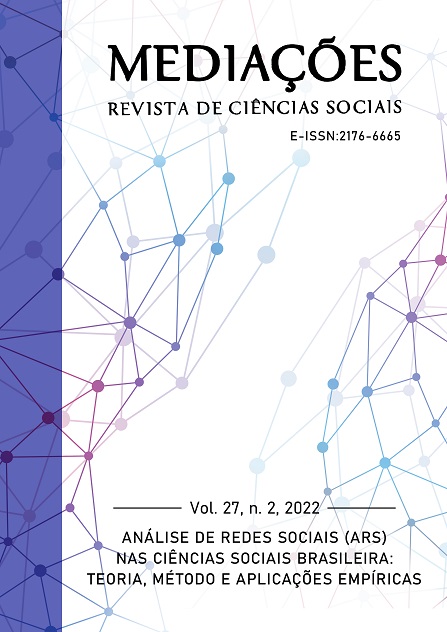Personal Networks Former Inmates and Entry into Labor Market
DOI:
https://doi.org/10.5433/2176-6665.2022v27n2e45729Keywords:
former inmates, networks, labor marketAbstract
This article analyzes how the personal networks former inmates are structured and how these networks, combined with other important factors - such as schooling, previous professional experience, trajectory in prison and stigma - impact the process of entry into of these individuals into the labor market. The data for analysis came from the application of semi-structured interviews and sociometric questionnaires to six prisoners from the Minas Gerais prison system. To analyze the data we use the technique of Social Network Analysis, more specifically, the Analysis of Personal Networks. The analyzes show that (1) the networks of these graduates are formed by predominantly strong ties and that (2) they present a low level of renewal; (3) the fear of prejudice further closes their personal networks; and (4) the first job can have a rejuvenating effect on the graduates' personal networks.
Downloads
References
BENSON, Michael L. Crime and life course an introduction. 2. ed. New York: Routlegde, 2012. DOI: https://doi.org/10.4324/9780203889893 DOI: https://doi.org/10.4324/9780203889893
BRASIL. Concelho Nacional de Justiça. Política de Atenção a Pessoas Egressas do Sistema Prisional. CNJ: Brasília, [2020]. Disponível em: https://www.cnj.jus.br/sistema-carcerario/politica-de-atencao-a-pessoas-egressas-do-sistema-prisional-escritorios-sociais/. Acesso em: 22 jul. 2022.
BURT, Ronald. Brokerage & Closure: an Introduction to social capital. Oxford: Oxford University Press, 2005. DOI: https://doi.org/10.1093/oso/9780199249145.001.0001
BUSHWAY, Shawn D. The Impact of an Arrest on the Job Stability of Young White American Men. Journal of Research in Crime and Delinquency, California, v. 35, p. 454-79, 1998. Doi: https://doi.org/10.1177/0022427898035004005 DOI: https://doi.org/10.1177/0022427898035004005
CAMPBELL, Bradley, MANNING, Jason. The Rise of victimhood culture: microagressions, safe spaces, and the new culture wars. Basingstoke: Palgrave Macmillan. 2018. DOI: https://doi.org/10.1007/978-3-319-70329-9 DOI: https://doi.org/10.1007/978-3-319-70329-9
COUNCIL OF STATE GOVERNMENTS. Report of the reentry policy council: charting the safe and successful return of prisoners to the community. New York: Council of State Governments, 2005.
ELDER, Glen H. Perspectives on life course. Ithaca: Cornell University Press, 1985.
FÓRUM BRASILEIRO DE SEGURANÇA PÚBLICA. Anuário Brasileiro de Segurança Pública: 2022. São Paulo: FBSP, 2022. Disponível em: https://forumseguranca.org.br/wp-content/uploads/2022/06/anuario-2022.pdf?v=4. Acesso em: 22 jul. 2022.
GOTTFREDSON, Michal R.; HIRSCHI, Travis. A general theory of crime. California: Stanford University Press,1990. DOI: https://doi.org/10.1515/9781503621794. DOI: https://doi.org/10.1515/9781503621794
GRANOVETTER, Mark. Ação econômica e estrutura social: o problema da imersão. RAE Electron, São Paulo, v. 6, n. 1, jan. 2007. DOI: https://doi.org/10.1590/S1676-56482007000100006. DOI: https://doi.org/10.1590/S1676-56482007000100006
GRANOVETTER, Mark. Economic action and social structure: the problem of embeddedness. American Journal of Sociology, Chicago, v. 91, n. 3, p. 481-510, 1985. Doi: https://doi.org/10.1086/228311. DOI: https://doi.org/10.1086/228311
GRANOVETTER, Mark. Getting a job: a study of contacts and careers. 2. ed. Chicago: The University of Chicago Press, 1995. DOI: https://doi.org/10.7208/chicago/9780226518404.001.0001. DOI: https://doi.org/10.7208/chicago/9780226518404.001.0001
GRANOVETTER, Mark. The old and the new economic sociology: a history and an agenda. In: FRIEDLAND, Roger; ROBERTSON, AF. (ed.). Beyond the marketplace: rethinking economy and society. New York: Routledge,1990. p. 89-112
GRANOVETTER, Mark. The strength of weak ties. American Journal of Sociology, Chicago, v. 78, n. 6, p. 1360-1380, 1973. DOI: https://doi.org/10.1086/225469. DOI: https://doi.org/10.1086/225469
JARDIM, Fabiana Augusta Alves. Chaves inúteis? transformações nas culturas do trabalho e do emprego da perspectiva de experiências juvenis de desemprego por desalento. Estudos de Sociologia, Araraquara, v. 16, n. 31, p. 493-510, 2011.
KIRK, David S.; WAKEFIELD, Sara. Collateral consequences of punishment: a critical review and path forward. Annual Review of Criminology, New York, v. 1, p. 171-194, 2018. DOI: https://doi.org/10.1146/annurev-criminol-032317-092045 DOI: https://doi.org/10.1146/annurev-criminol-032317-092045
LOPOO, Leonard M.;WESTERN, Bruce. Incarceration and the Formation and Stability of Marital Unions. Journal of Marriage and the Family, New York, v. 67, n. 3, p. 721-34, 2005. DOI: https://doi.org/10.1111/j.1741-3737.2005.00165.x. DOI: https://doi.org/10.1111/j.1741-3737.2005.00165.x
LYNCH, James P.; SABOL, William J. Prisoner reentry in perspective. Washington: The Urban Institute, 2001.
MISCHE, ANN. Partisan Publics: communication and contention across brazilian youth activist networks. Nova Jersey: Princeton University Press, 2007.
PAGER, Devah. Marked: race, crime, and finding work in an era of mass incarceration. London: The University of Chicago Press, 2007. DOI: https://doi.org/10.7208/chicago/9780226644851.001.0001 DOI: https://doi.org/10.7208/chicago/9780226644851.001.0001
PAGER, Devah; QUILLIAN, Lincoln. Walking the talk? what employers say versus what they do. American Sociological Review, Chicago, v. 70, p. 355-380, 2005. DOI: https://doi.org/10.1177/000312240507000301 DOI: https://doi.org/10.1177/000312240507000301
PAIXÃO, Antônio Luiz. Recuperar ou punir? como o estado trata o criminoso. São Paulo: Cortez, 1987.
PETTIT, Becky; LYONS, Christopher J. Status and the stigma of incarceration: the labor-market effects of incarceration, by race, class, and criminal involvement. In: BUSHWAY Shawn D.; STOLL Michael A.; WEIMAN David. Barriers to Reentry?: The Labor Market for Released Prisoners in Post-Industrial America. New York: Russell Sage Foundation. 2007.p. 203-226
PETTIT, Becky; WESTERN, Bruce. Mass imprisonment and the life course: race and class inequality in US incarceration. American Sociological Review, Chicago. v. 69, n. 2, p. 151-169, 2004. DOI: https://doi.org/10.1177/000312240406900201 DOI: https://doi.org/10.1177/000312240406900201
PETTIT, Becky; WESTERN, Bruce. The livelihood of man. New York; San Francisco; London: Academic press, 1977.
RAILEY, Michael G.; PETERSON, Gary. The Assessment of Dysfunctional Career Thoughts and Interest Structure Among Female Inmates and Probationers. Journal of Career Assessment, v. 8, n. 2, p. 119-129, 2000. Doi: https://doi.org/10.1177/106907270000800202. DOI: https://doi.org/10.1177/106907270000800202
SABOL, William J. Local labor-market conditions and post-prison employment experiences of offenders released from Ohio State Prisons. In: BUSHWAY Shawn D.; STOLL Michael A.; WEIMAN, David. Barriers to reentry?: the labor market for released prisoners in post-industrial America. New York: Russell Sage Foundation. 2007. p. 257-303
SHIVY, Victoria A; WU, Juana J.; MOON, Anya E.; MANN, Shay C.; HOLLAND, Jo G.; EACHO, Christine. Ex-offenders reentering the workforce. Journal of Counseling Psychology, Arlington, v. 54, n. 4, n. 466- 473, 2007. DOI: https://doi.org/10.1037/0022-0167.54.4.466 DOI: https://doi.org/10.1037/0022-0167.54.4.466
SILVA, Marcelo Kunrath; ZANATA JR., Rui. Diz-me com quem andas, que te direi quem és: uma - breve - introdução à análise de redes sociais. REVISTA USP, São Paulo, n. 92, p. 114-130, dez./fev. 2011/2012. DOI: https://doi.org/10.11606/issn.2316-9036.v0i92p114-130
SIMMEL, Georg. Sociologie: études sur les formes de la socialisation. Paris: Presses Universitaires de France, 1999.
SMITH, David M.; WOODBURY, Stephen A. Low-wage labor markets: the business cycle and regional differences. Washington: Department of Health and Human Services, 2020.
STEINER, Philippe. A sociologia econômica. São Paulo, Atlas, 2006.
VERNICK, Stacie H.; REARDON, Robert C. Career development programs in corrections. Journal of Career Development, California, v. 27, n. 4, p. 265-277, 2001. DOI: https://doi.org/10.1023/A:1007803120403 DOI: https://doi.org/10.1177/089484530102700403
WESTERN, Bruce. Punishment and Inequality in America. New York: Russell Sage Foundation. 2006.
WESTERN, Bruce; LOPOO, Leonard M., MCLANAHAN, Sara. Incarceration and the Bonds between Parents in Fragile Families. In: PATTILLO, Mary; WEIMAN, David; WESTEM, Bruce. Imprisoning America: The Social Effects of Mass Incarceration. New York: Russell Sage Foundation. 2004. p. 21-45.
Downloads
Published
How to Cite
Issue
Section
License
Copyright (c) 2022 Daniel Araújo de Azevedo, Rafaelle Lopes Souza, Alexandre Silva Nogueira

This work is licensed under a Creative Commons Attribution 4.0 International License.
Copyright on articles published in Mediações belongs to the author(s): in the case of partial or entire republication of the original publication, we ask author(s) to indicate the original publication in the periodical.
Mediações uses the Creative Commons Attribution 4.0 International license, which allows Open Access, enabling any user to read, download, copy and disseminate its content so long as adequately referenced.
The opinions expressed by the author(s) are their sole responsibility.
































